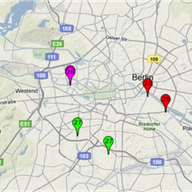
RIPE Chair Selection - Next Steps
• 8 min read
Please find below an update from the RIPE Nominating Committee. Three of the NomCom members answer some of the questions you might have about the next steps in the selection process.

Based in Western Europe, NL&DE mostly
Articles
Likes on articles

>>>>>>>>>>>> https://www.ripe.net/about-us/press-centre/publications/speakers/daniel-karrenberg <<<<<<<<<<<< Ample information about his past sins can be found using your favourite search engine. Following are a few additional keywords you might use, arranged by decade: 1980s: GUUG EUUG EUnet unido mcvax cwi RARE iepg RIPE; 1990s: RIPE+NCC rir iana postel terena ebone centr k.root-servers.net; 2000s: dnsmon nsd ris internet+society rssac; 2010s: ripe+labs ripestat ripe+atlas
Email: daniel.karrenberg@ripe.net
Website: https://www.ripe.net/about-us/press-centre/publications/speakers/daniel-karrenberg

• 8 min read
Please find below an update from the RIPE Nominating Committee. Three of the NomCom members answer some of the questions you might have about the next steps in the selection process.

• 10 min read
March 1992 - NIKHEF Amsterdam - Main Computer Room: "We have connectivity!" Marten called out. "Running the check script." Daniel responded. The two young engineers were intently looking at their screens, totally oblivious to anything around them: the noise of the air-conditioning fans, the bli…

• 15 min read
This work demonstrates the value of the results collected by RIPE Atlas independent of the original purpose for collecting them. Using all traceroute results from a particular day as an example, we first show that near real-time analysis of the result stream is feasible. Then we show that this has …

• 14 min read
View maps based on RIPE Atlas traceroute measurements. Compare the maps to the ISP's description of their topology. See the potential of RIPE Atlas for mapping the packet layer topology. Learn about experimental tools you can use yourself to explore. Make suggestions for further work.

• 3 min read
On Wednesday 13 June 2012, an unknown error caused the removal of several zone files from the configuration of our reverse DNS provisioning system. Following up from the initial report published on RIPE Labs, we further analysed what caused the incident and implemented a number of procedures to dec…

• 4 min read
RIPE NCC members can browse RIPE database objects with history in RIPEstat for a couple of weeks as a demonstration. Please check it out and let us know what you think.

• 4 min read
In addition to the existing global and local instances of K-root, we propose member instances of K-root. This article describes the benefits and how this will be implemented during the pilot phase.

• 6 min read
Bringing high-quality independent measurements to your network!

• 8 min read
Last week there were several problems with the RIPE NCC's reverse DNS (rDNS) service. This article is a first report about the events. It is not intended to analyse the causes or make detailed recommendations for action.

• 3 min read
In anticipation of reaching the last /8 of IPv4 addresses in the RIPE NCC service region, we have been looking at the number of IPv4 addresses the RIPE NCC handed out over the last four years. The curves look surprisingly uniform.

• 2 min read
In this episode of the RIPE Labs podcast, three Internet pioneers talk about how they helped grow the Internet out of its early infancy, back when its purpose - and much of the excitement around its development - lay in the promise of connecting researchers from around the world.

• 7 min read
Our cloud strategy framework provides a starting point that we will use when developing cloud implementations in the future. It also forms a solid basis for discussions with the community on specific proposals relating to our services.

• 4 min read
Following the Facebook outage that took place on 4 October, we saw people looking to BGPlay to get a better view of what went on. Here's a look at what the RIPEstat visualisation has to show us about the event in question.

• 11 min read
Our draft cloud strategy framework is an attempt to bring everything together in a way that sets out some boundaries, identifies critical elements, and indicates where we need to be strict vs where we can afford to be a little more relaxed. This should hopefully support more clarity regarding how w…

• 8 min read
The community’s reaction to our cloud proposal at RIPE 82 was stronger than we expected. We think it’s worth re-starting this discussion, and the first step is to check that we’ve heard you correctly.

• 4 min read
At the Internet Governance Forum this week, we signed an MoU with CENTR, the European association of country-code Top Level Domains (ccTLDs). This seemed like a good opportunity to revisit some of the shared history between our two organisations.

• 8 min read
This article is intended to make RIPE Atlas users aware of ethical issues that could arise when using RIPE Atlas. We do not intend to propose any new formal processes or procedures to address the relevant ethical issues, but we do want to encourage members of the RIPE Atlas community to consider th…

• 3 min read
During the RIPE 70 Meeting in Amsterdam this week (on 13 May around 10:00 UTC), we experienced a network outage at AMS-IX. Let's see how this was monitored by various tools.

• 2 min read
Similar to an experiment done for IPv4 address space, Merit is now performing a darknet experiment with the IPv6 ranges that have been allocated to the RIRs. This also includes prefixes allocated to the RIPE NCC.

They are suggestions, so do not take them as instructions! Especially the defaults I suggested should be subject to discussion and community feedback. As to keeping the probes visible: I do not think that this is what the typical user wants when they are interested in the topology close to the *target*. In any case what I was interested in when I used traceroutes like that was a simple representation of the topology close to the target, never mind how the packets got close. Daniel
Suggestions: a) add an option to limit to h hops from the target and then show paths from all probes providing data during the interval b) use 'network names' as a label option c) use AS 'names' as a label option d) use a colour scale (better visual resolution than greyscale) for the number of paths along an edge e) add an option to only show endgs used by at least p % of all probes providing data during the interval f) make h=4 and p=25 the default view For examples of all that see https://labs.ripe.net/Members/dfk/map-a-ripe-atlas-anchor Daniel
Showing 22 comment(s)